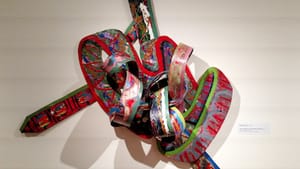Stay in the Loop
BSR publishes on a weekly schedule, with an email newsletter every Wednesday and Thursday morning. There’s no paywall, and subscribing is always free.
A new language
PAFA presents 'A Collaborative Language: Selections from the Experimental Printmaking Institute'

PAFA's new exhibition, A Collaborative Language: Selections from the Experimental Printmaking Institute shows off the diversity of founder and master printmaker Curlee Raven Holton’s vision.
Holton joined the faculty at Lafayette College in Easton, Pennsylvania, in 1991, both to teach African-American art history and to develop a collaborative printmaking curriculum at an institution that had little interaction with such a concept.
A collectivist vision
However, by 1996, with the initiation of the Experimental Printmaking Institute (EPI), Holton’s collectivist vision embraced the grand traditions of its form. Its DIY sense of pragmatism was essential to the university’s modest accommodations, and an interactive, collaborative expression proved essential for like-minded African-American artists heading into the 21st century. EPI, from its start, was a movement, a group of unique artists and artisans touching on subjects such as protest, romance, satire, religion, reproductive rights — all undulating as one organism.
Holton gifted more than 60 EPI prints to PAFA. These are on display in the Academy’s Works on Paper mezzanine gallery. The pieces show EPI’s role in creating new dialogues between artist, technician, audience, and, in the case of the university, students. All express what Holton calls “the infinite possibilities of paper.”
Afrocentrism on paper
The unified themes (beyond the use of paper) and coolly passionate Afrocentrism that touch A Collaborative Language only hit you after you’ve taken in the entire exhibition. Individually, each work possesses its own brand of erudition, humor, decoration, and adoration of form and topic.
Melvin Edwards’s chainlink and heart necklace motifs (across several works) share their Pop sensibility and shadows with Warhol. David Driskell toys with the notion of kiddie “scratch art” (black crayon over multicolored crayon) on the monotype Hat That Was Her Halo, with a playful color and tone similar to fellow EPI member and Africobra member Nelson Stevens’s decorous, Cubist-inspired works. Kevin Cole’s white-on-white, aptly titled Embossment, is reminiscent of the cover art from several of Jay-Z’s most recent albums.
Grant Wood’s staunchly caucasoid Americana gets hilariously lampooned by Newark artist Willie Cole in American Domestic, a work whose pitchfork-carrying married farmers are replaced by African masked faces, a puka-bead headdress, and the repeated imagery of steam irons (which Cole utilizes to scorched effect in other EPI works).
Alison Saar’s dramatic and Germanic woodcut of naked women, Briarpatch Blues, is simple and stark, but matched in its bare bones eloquence by her Mami Wati. These leaflets, scrolls, and pamphlets, dedicated to individualist stripes of empowerment, recall the impact of flooding on the black community. Robin Holder’s purplish serigraph, They Damaged Us More Than Katrina, looks at the deadly power of water on the black community, but has a primal scream at its root.
Where powerful sociocultural commentary is concerned, however, Curlee Raven Holton’s own Fecund lithograph, dedicated to women’s reproductive rights and with a submerged-femme heroic centerpiece split between reds and blacks, is most challenging, spirited, and potent in its symmetry and imagery.
What, When, Where
A Collaborative Language: Selections from the Experimental Printmaking Institute. Through November 5, 2017, at the Pennsylvania Academy of Fine Arts,118-128 N. Broad Street, Philadelphia. (215) 972-7600 or pafa.org.
Sign up for our newsletter
All of the week's new articles, all in one place. Sign up for the free weekly BSR newsletters, and don't miss a conversation.
 A.D. Amorosi
A.D. Amorosi